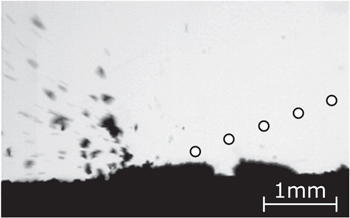Planet. Sci. J. 3 195 DOI 10.3847/PSJ/ac8477 10.3847/PSJ/ac8477
Becker, T., Teiser J., Jardiel T., Peiteado M., Munoz O., Martikainen J., Gomez Martin J.C., Wurm G.
Emission of dust up to a few microns in size by impacts of sand grains during saltation is thought to be one source of dust within the Martian atmosphere. To study this dust fraction, we carried out laboratory impact experiments. Small numbers of particles of about 200 μm in diameter impacted a simulated Martian soil (bimodal Mars Global Simulant). Impacts occurred at angles of ∼18° in vacuum with an impact speed of ∼1 m s−1. Ejected dust was captured on adjacent microscope slides and the emitted particle size distribution (PSD) was found to be related to the soil PSD. We find that the ejection of clay-sized dust gets increasingly harder the smaller these grains are. However, in spite of strong cohesive forces, individual impacts emit dust of 1 μm and less, i.e., dust in the size range that can be suspended in the Martian atmosphere. More generally, the probability of ejecting dust of a given size can be characterized by a power law in the size range between 0.5 and 5 μm (diameter).

Image of an impact, showing the impactor as a white circle as well as a cloud of ejecta.